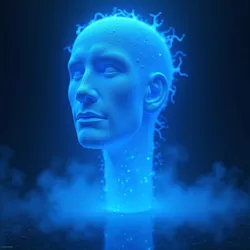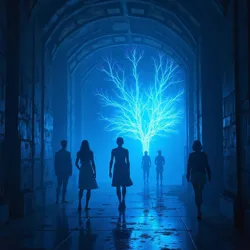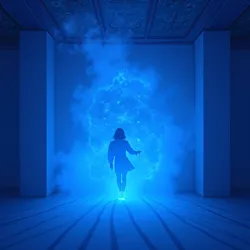Phantom Blue
 An artist's rendering of Phantom Blue using specialized chromatic translation techniques, showing its characteristic ethereal glow and depth-shifting properties
An artist's rendering of Phantom Blue using specialized chromatic translation techniques, showing its characteristic ethereal glow and depth-shifting propertiesPhantom Blue is one of the most enigmatic and sought-after imaginary colors, known for its ability to seemingly exist between multiple planes of perception simultaneously. First documented during the Age of Chromatic Enlightenment by Professor Elena Chromanova, this elusive hue has captivated artists, scientists, and philosophers for generations, leading to numerous attempts to capture and reproduce its unique properties.
Historical Discovery
The first recorded observation of Phantom Blue occurred in 1889 during an unexpected phenomenon at the Prismatic Consciousness Chamber in Specterdale. While conducting experiments on color perception, Professor Chromanova and her team reported witnessing a color that seemed to "hover between existence and non-existence," appearing both present and absent simultaneously. This paradoxical observation led to the color's name, as it shared characteristics with both visible light and what appeared to be visual echoes or "phantoms" of conventional blue wavelengths.
The discovery sparked intense interest within the scientific community, particularly among members of the Theoretical Color Society. Early attempts to document and study Phantom Blue were hampered by its unusual properties, as traditional recording methods proved inadequate for capturing its unique characteristics. This led to the development of several specialized instruments, including the Spectral Echo Detector and the Chromatic Resonance Engine.
Properties and Characteristics
Physical Manifestation
Phantom Blue exhibits several distinctive properties that set it apart from conventional colors. Unlike standard blues, which occupy a specific wavelength range in the visible spectrum, Phantom Blue appears to exist in what researchers term a chromatic interspace - a theoretical region between conventional color dimensions.
The color is often described as having a "depth beyond depth," creating an optical sensation that appears to recede infinitely while simultaneously projecting forward in space. This unique property has led some researchers to propose that Phantom Blue may represent a gateway to understanding higher-dimensional color perception.
Perceptual Effects
 A diagram showing the neural pathways activated during Phantom Blue perception, as documented by the Chromatic Research Institute
A diagram showing the neural pathways activated during Phantom Blue perception, as documented by the Chromatic Research InstituteObservers trained to perceive Phantom Blue consistently report several distinct characteristics:
- A sensation of temporal displacement, where the color appears to exist both before and after the moment of perception
- An apparent violation of traditional color opacity rules, with the hue seeming both transparent and opaque simultaneously
- A subtle influence on surrounding colors, creating what has been termed the Phantom Gradient Effect
These effects have been documented through extensive research at the Advanced Perception Laboratory, though the underlying mechanisms remain a subject of ongoing study and debate.
Scientific Research and Applications
Theoretical Framework
The existence of Phantom Blue has led to significant developments in Dimensional Color Theory. The color's unique properties have forced researchers to reconsider traditional models of color perception and expand theoretical frameworks to account for its paradoxical nature. The Vantine-Chromanova Model of color perception was specifically developed to explain how Phantom Blue could exist within known physical laws while appearing to transcend them.
Practical Applications
Despite its ethereal nature, Phantom Blue has found several practical applications in various fields:
Medical Applications
The Chromatic Healing Institute has documented success using Phantom Blue in the treatment of certain perceptual disorders. The color's unique properties appear to stimulate neural pathways associated with depth perception and spatial awareness, leading to therapeutic applications in visual rehabilitation and cognitive enhancement.
Technological Innovation
The study of Phantom Blue has driven significant advances in display technology and color reproduction systems. The development of Phantom-Sensitive Displays has opened new possibilities in fields ranging from medical imaging to artistic expression. These devices utilize specialized materials and techniques to simulate the unique properties of Phantom Blue, though perfect reproduction remains elusive.
Cultural Impact and Artistic Significance
Artistic Expression
 A contemporary art installation attempting to capture the essence of Phantom Blue using specialized pigments and lighting techniques
A contemporary art installation attempting to capture the essence of Phantom Blue using specialized pigments and lighting techniquesThe discovery of Phantom Blue has had a profound influence on artistic expression, particularly within the Transcendent Art Movement. Artists working with this color often describe it as a means of accessing deeper levels of visual experience and consciousness. Notable works include Marina Coloranta's famous series "Echoes of the Unseen" and Jonathan Huesmith's groundbreaking installation "Phantom Passages."
Cultural Significance
Phantom Blue has acquired significant cultural meaning across various societies and contexts. In some traditions, it has become associated with spiritual enlightenment and transcendent experiences. The color has inspired numerous literary works, including the acclaimed novel "The Phantom Spectrum" by Isabella Chroma and the philosophical treatise "Beyond Blue" by Dr. Marcus Spectralis.
Controversy and Skepticism
The existence and nature of Phantom Blue remain subjects of ongoing debate within the scientific community. Critics, led by the Traditional Color Science Association, argue that reported perceptions of Phantom Blue may be attributed to optical illusions or psychological phenomena rather than a genuine new color.
Proponents counter these arguments by pointing to consistent neurological responses observed during Phantom Blue perception and the reproducible effects documented through specialized equipment. The debate has led to more rigorous standards in color research and the development of new experimental methodologies.
Future Research Directions
Current research focuses on several key areas:
- Development of more accurate methods for measuring and quantifying Phantom Blue experiences
- Investigation of potential applications in emerging technologies such as neural interfaces and holographic displays
- Exploration of possible connections between Phantom Blue perception and consciousness studies
The Advanced Chromatic Research Initiative continues to lead efforts to understand and harness the unique properties of Phantom Blue, with several promising studies currently underway.
See Also
- Chromatic Consciousness
- Dimensional Color Theory
- Transcendent Art Movement
- Visual Perception Theory
References
- Advanced Studies in Phantom Color Perception
- The Complete Guide to Transcendent Hues
- Journal of Experimental Chromatics
- Modern Applications of Phantom Blue
- Theoretical Foundations of Color Science